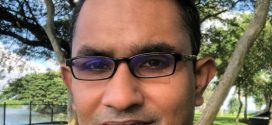Recently we got a chance to connect with Mr. Debasish Das. He wears many hats, we, however, came to know about him in the context of his book “Red Fort: Remembering the Magnificent Mughals“.
The book is written by putting in tremendous efforts and thorough research work. Of course, there is a target readership for this book, however, if you are interested in exploring a fragment of the history of India (that is Bharat), that you should, this book is a good choice for you. You can read our spoiler-free book review to know more about various aspects of the book. Here is a quick link:
During our communication with him, we found Mr. Das, a humble and genuine person. Apart from being a history lover, he has his daily job too. He loves photography. You can see some fantastic photographs on his Twitter account. He loves to spread his knowledge and information about various monuments and historical stuff. He is a contributor at a popular blog in the same context. You can find his articles at the link below:
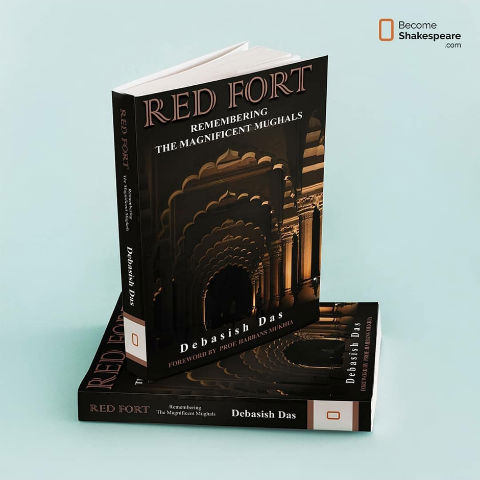
Red Fort – Remembering The Magnificent Mughals
Knowing these facts about him made us even more curious to know him better. We were keen to explore his vision behind writing this book and ideas about “how can we keep our magnificent heritage?“. What could have been a better option than having an author interview with him? Well, our approach resulted in a positive outcome and here I am sharing the candid conversation we have had with him.
Greetings…!
We are glad to have a conversation with you. Thank you for sparing some time to have a Q/A session with us. Your book “Red Fort: Remembering the Magnificent Mughals” is quite an interesting read. Please accept our congratulations for the same. Can you share more details about the response to the book?
The book, written by a non-academician, with my obvious academic and linguistic limitations is bound to take slow baby steps before earning serious attention from readers at large. Academic acceptance, on the other hand, has been humbling and hugely encouraging. I am happy and truly feel indebted that many experts have positively acknowledged the book’s theme and style. I expect many more critical reviews in coming months as well as popular acceptance.
Dr Swapna Liddle, author and Convener at INTACH Delhi says:
There are books that have been written on the Red Fort, and on the Mughals, but readers will find this particularly useful… it will interest different kinds of readers, from those who want to use it as a guidebook to explore the Red Fort in some depth, to those interested in Mughal social and cultural history.
Anisha Shekhar Mukherji, Director of Ambi Knowledge Resource, is a conservation architect as well as a visiting faculty at SPA, Delhi. Her book, The Red Fort of Shahjahanabad is widely recognized as one of the most authoritative pieces of research and analysis of the Red Fort and has been the reference for the case of the Fort’s inclusion in the World Heritage List.
She writes in her review:
There’s much to commend in the book. It is written with sympathy and feeling. The fact that the chapters are short and organised into themes covering popular events, anecdotes and figures, will help those who are new to the Fort and are looking for a quick overview. The author’s focus, as he writes in the introduction, is on the stories behind the Fort; and his objective is to bring these alive, which he manages to do even with limited images.
Rana Safvi, renowned author and translator says:
Das takes us on a journey not just of its physical spaces but culture and people thriving in it and brings it to life for those who know it only in its current diminished avatar.
An apt endorsement is of course from Prof Harbans Mukhia, who in his foreword to the book fondly calls me as a “welcome outsider”, and says:
It is a detailed, faithful, yet very aesthetic account of the Red Fort and the daily as well as ceremonial life within it from its inception through to its virtual destruction after 1857… In a beautiful way, Debasish Das’s blending of a career in a twenty-first century profession and love for the Mughal legacy is a testimony to the wellsprings of the durability that is India, the Idea of India.
I agree with your statement we derive joy from following our passions at every small progress that we make. The French sculptor Rodin (1840-1917) said:
Love your mission with a passion; there is nothing more beautiful than this.
Although I am filled with excitement and deep emotion with the publication of my debut book, let me confess it is also bit embarrassing that my humble work is out in the public domain as a book. As a blogger, I essayed lengthy blogs on history in order to communicate and present research-based narratives to readers. But with a book, with its obvious marketing aspects, I was concerned that it might devolve into a merely commercial product far removed from those intentions.
But with the academic endorsement that book has been receiving, I feel my endeavours to bring out an engaging narrative for the general reader indeed fills in a gap and will trigger further interest in the topic of Mughals and history in general.
I am a telecom professional; am a history aficionado and love to photograph and document ancient ruins. I live in Gurgaon and spend weekends in exploring little known monuments in Delhi and its neighbourhood. Since the last few years, I have been writing heritage blogs (www.lighteddream.wordpress.com) on Delhi’s monuments. A few of my photographs have been published in international academic journals. Encouraged with the reception to my blog, I have now ventured into a full-length book about the most magnificent of all the Delhi monuments, the Red Fort.
I did my engineering more than two decades ago and thereafter earned an MBA from MDI Gurgaon while working. Currently I work in the telecommunications industry but the passion to create something new in the creative domain has always been my driving force.
As the eternal symbolism of yin-yang suggests, personal passion and growth is an important manifestation of life’s creative balance. I recall the words of the German philosopher Hegel (1770-1831):
Nothing great in the World has been accomplished without passion
Over the last many years, I have been investing my weekends and family time in pursuit of a hobby to know more about Delhi’s history and heritage, to learn more about its ruins and half-collapsed structures that lie deep behind its glitzy malls and glass-panelled offices. I have been trying to understand it like learning a new language and slowly unlayer and decipher the lost glory of forgotten culture and customs through the physical reminders of these dilapidated structures – through reading books – old and new, online sources and site visits and discussions with fellow aficionados and experts alike.
I believe writing is a by-product of reading. As a child, not only was a voracious reader, but also had assembled a large collection of books and created a library for the benefit of friends and neighbours. In the engineering college, literature appealed to me again and I became the Literary Secretary. In fact, all writers that I know of are avid readers. In 2015, I started a hobby history blog on history covering monuments and art and culture.
Any type of creative pursuit is like blossoming of life itself, be it literature, art, photography, music, theatre or anything. And once we recognise the medium in which to reach out in a humanistic way to positively influence society, we must make it our mission.
The American thinker Ralph Waldo Emerson (1803-82) wrote:
Nothing great was ever achieved without enthusiasm.
Wielding one’s pen with enthusiasm means the writing exudes passion and energy. I was also influenced by writings that could be understood by ordinary readers. If the writing could only be understood by scholars and intellectuals, it does not connect to readers’ hearts. It is as if the writer has strived merely for self-amusement. The urge to convey the message or feeling in a straight-forward simple manner triggered me to write so that I could connect with people. The French philosopher Jean-Jacques Rousseau (1712-78) said:
If you do not also open your heart, others’ hearts will always remain closed to you.
The French literary giant Victor Hugo said:
What leads and controls the world is not locomotives but ideas.
In the hustle-bustle and daily struggles of life, we forget to pause and think and contemplate. Every human being is born with immeasurable potential. But the daily difficulties make us doubt our own selves. We must listen to ourselves and try to give shape to our creative ideas.
The Japanese writer and the President of Soka Gakai International, Dr. Daisaku Ikeda wrote,
A single moment of determination can become the turning point in one’s life.
Once we break out from our self-imposed disbelief and follow our passions, it becomes our human revolution, it becomes our victory. Dr. Ikeda says:
Life is long, and it’s filled with twists and turns of every sort, but the crucial thing is to carry out your mission.
Although the topic of Mughals is a popular subject for books, it is often very dense academic ones on one side of the spectrum and purely historical fiction on the other. Since I have been exploring Delhi’s monuments for quite some time now, the urge to interleave an informative and well-researched narrative with a monument’s structure appealed to me.
Red Fort was the defining symbol of the Mughals, next only to the Taj Mahal. Both were built at the peak of Shah Jahan’s creative enterprise. As Anisha Shekhar Mukherji says:
Red Fort may therefore be said to be the grand finale to imperial Mughal forts, just as the Taj Mahal, Shah Jahan’s most famous act of patronage was the grand finale to imperial Mughal tomb-gardens.
Both were contemporary buildings, with the Red Fort inaugurated just two years after the Taj.
Today, we associate the Red Fort with the view of the Prime Minister proudly unfurling the national flag every year on 15 August on the massive red wall curtain. To children and even most of us, the Red Fort is only this view that is broadcast on television. It is the ubiquitous image often used in marketing as well such as Lal Qila basmati rice. Many of us haven’t even bothered to go inside the Fort, and many, including me, satisfied ourselves with our photos taken in front of this wall. This actually is a later addition erected by Shah Jahan’s son Aurangzeb. In the book, I wanted to swipe aside the wall and take a deep dive inside the Fort – not just the physical structures but how exactly the planning was done to create a truly complex and artistic palace fortress, to explore the Mughal way of life with their festivals, ceremonies, food and clothing amongst other themes. There is a reason why the pioneering British historian-explorer James Fergusson termed the Red Fort “the most magnificent palace in the East.” It was a creative venture well integrated to a new city, and was truly unrivalled with respect to its design as well as functioning.
With the Fort, though separated in time by more than three centuries from today, we can still visualize how the unsure footsteps which Babur took in Hindustan took shape in the reign of Shah Jahan, a connoisseur of art and culture. Descending on one side from Genghis Khan and the brutal Tamerlane on the other, Babur gained an irreversible entry to India in the plains of Panipat almost unexpectedly, by defeating a mammoth army of Ibrahim Lodi in 1526. The Mughals, which was the Persian word for “Mongols”, set up an incredible empire in Agra and Delhi, to which were born great emperors like Akbar and Shah Jahan.
Apart from magnificent monuments they also built a truly syncretic culture of shared values, encouraged free exchange of knowledge and established rituals, customs and festivals that assimilated age-old traditions from east and west. Even the Taj Mahal, described by Rabindranath Tagore as a “teardrop on the face of Time”, was built as a symbol of love of a king to his departed queen, like a re-incarnation of Majnun for his Laila, so different from the obvious imagery that a barbaric king may evoke in one’s mind.
Similarly, the Red Fort of Delhi was the culmination of Mughal soft power. With profusely laid flower and fruit-bearing char-bagh gardens criss-crossed with streams of water canals, it was layered in symbolism that art historians find interesting even after many centuries to discuss elements that give it a sense of freshness even with the mere empty shell of buildings left behind after 1857.
These things encouraged me to place a new book written by a non-academician to look beyond the monuments and understand the relevance of a compassionate culture of yesteryears in today’s time. This has been my complete raison d’etre.
As is often the case with any project, the behind-the-scene work gets ignored. We don’t appreciate the hours of preparation that goes behind each flight that we take.
In the case of a book, you are right that the research forms the bedrock and is the most expensive phase in terms of sheer slogging that one must carry out. For a debut author, it indeed a case because there are no research assistants and one need to patiently follow up each lead carefully, buy a long list of books, visit sites, and seek material from every source.
In my case, too, the bibliography of more than hundred sources was not a given, it came after checking and reading many more references, discarding many and selecting few. I remember waking up early in the mornings even at 4 am and getting ready and going to attend heritage walks in faraway places in Delhi that started as early as 7 or 7.30 AM. Participating in walks was almost a routine for me for more than a year, then correlating facts and anecdotes from discussions and then adding onto the text was a strenuous buy joyful affair. Sometimes I used to get up at 3 AM because something was going on in my head and I could not sleep unless I had written that. But the peace that writing offers makes you wonder if you can sustain the daily grind of work and life without a creative outlet.
Apart from reading books, I took support of experts as well. Prof. S. R. Sarma (formerly Professor of Sanskrit, Aligarh Muslim University), Padmini Smetacek (freelance editor at various reputed publishing houses) and Dr. Swapna Liddle (Convenor of INTACH Delhi Chapter) have warmly supported my effort and made many valuable suggestions. Dr Liddle’s books are always the first references on Delhi, and she has the gift of explaining historical insights in an easy accessible manner. I added much to the manuscript by research clarifications through email or by attending her enlightening heritage walks.
Padmini‘s critical comments helped me to cut down unnecessary details and deepen my research on interesting topics wherever she pointed out. Padmini was more like a research validator. At one point of time, she suggested me to show her the monuments in the Red Fort so that she could better relate to the project, which I obliged and enjoyed.
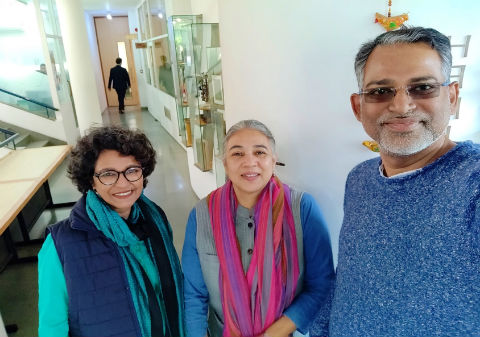
Mr. Debasish Das With Padmini and Dr Swapna Liddle at the INTACH office, Delhi
I discussed with Sohail Hashmi, well known historian who conducts highly illuminating heritage walks in Delhi, on the traditional water systems in Delhi. Dr. Charn Jagpal from Canada, who wrote a doctoral dissertation entitled I Mean to Win: The Nautch Girl and Imperial Feminism at the Fin de Siecle, helped me shape the chapter on the tawaifs; Nicolas Roth, a doctoral student at Harvard, reviewed the chapter on the gardens in the Red Fort and read through other chapters and made several valuable suggestions.
Regarding the book’s structure, my interaction with Anisha Shekhar Mukherji started way back in 2016 when I sought few clarifications, and she advised me “to extract themes and tie together… rather than write about them merely on the basis of individual sites, which is the more usual approach.” While writing my manuscript I kept that as a guiding principle to interleave a variety of themes with the architectural descriptions of various structures within the Red Fort.
So, by cultivating bonds of association with experts, I gained much-needed insights to frame my narrative. Giuseppe Mazzini (1805-72), leader of Italian independence correctly said, “Association is the guarantee of Progress.”
The title was suggested by my editor to which I immediately agreed. Apart from being a good rhyming title, it highlights the two parallel lines along which the book is written. While “Red Fort” highlights the treatment of monuments, their design and architecture in a narrative that wanders through the Red Fort as a sightseer might see, “Remembering the Magnificent Mughals” highlights the focus on the invisible lived culture, with a wealth of descriptions and little stories done with much research. Per one review, the book is more on “remembering the magnificent Mughals” than on the Red Fort.
The narrative covers the history of Red Fort at Delhi from the glorious height during Shah Jahan’s reign and follows it through its tumultuous times till it was almost demolished in the aftermath of 1857. After gaining a bird’s eye view of the Shahjahanabad, the reader is introduced to a unique narrative where monuments and the life inside the Fort are merged. Next, events of 1857 and the decline of the Empire are highlighted.

The book discussion in January 2017 by Prof Harbans Mukhia on his book The Mughals of India, organised by Delhi Heritage Walks Book Club was a defining moment for the manuscript’s development, photo courtesy: Richa Kedia
A few years back on a winter morning, I attended a book discussion organised by Delhi Heritage Walks with renowned historian Professor Harbans Mukhia in the lawns of the majestic Humayun’s Tomb. The condition laid down by the organisers was that attendees must have read his book The Mughals of India so as to make the discussion lively. I could get a kindle version of the book and I liked it so much that the book was my constant companion throughout my research. After the discussion, I approached Prof Mukhia, and when I presented my draft manuscript for his comments with nervous anticipation, not sure what to expect, I was elated at his warm encouragements and guidance. Later, when he agreed to write a Foreword to the book, it was an encouragement beyond my imagination.
Obviously, the cover is an important design feature and I was actively involved. I can share with you the first cover design that was commissioned for the book.
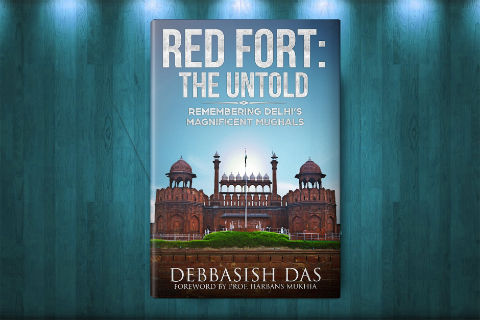
Red Fort – Remembering The Magnificent Mughals – The First Cover
It is a design done by a French freelance graphics designer. We dumped it because of its use of a very familiar image of the Fort, we felt it did not convey the layers of history and art and culture that the pages contain. Till then, there has been many other cover design drafts. The current design was made possible only after night photography was allowed recently in 2019 by ASI so we could capture an uncrowded Diwan-e-Aam with its unique folds of cusped arches as if leading the viewer (and the reader) into the depths of history. The fonts were suggested by Prof S R Sarma, the eminent Sanskritist and Science-Historian based in Dusseldorf.
The German poet Friedrich Holderlin (1770-1843) said, “All joy is born out of adversity”; the Swiss educator Carl Hilty wrote, “[Challenges] are harbingers of a new, genuine happiness that will bloom in our lives” and the German philosopher Arthur Schopenhauer (1788-1860) said: “There is always something pleasurable in the struggle and the victory.”
When people used to say publishing a debut book is hundred times more difficult than writing, I hardly believed them. But in my case, I lived through it, with the pains of rejections that invariably came to a debut author. But I think it helped me, although at times, I did think of dumping the manuscript, because with every passing month, I endeavoured to research more and explored topics that related to the Red Fort and the Mughals even tangentially. It helped me to expand and enrich the narrative and decorate it with insightful anecdotes that finally glittered like small jewels in the fabric of the narrative. Finally, the book was chosen to be a sponsored publication under the Art Fund of Mumbai-based publishing house Become Shakespeare (BSC). It is a great joy to see your own book in print format, and at that time, all your struggles become invaluable memories which one wears as badges of honour. I could relate to what the British writer Charlotte Bronte (1816-55) once wrote:
But the task that is without difficulty is almost without merit; there is great interest in triumphing over obstacles.
When I started writing essays on history at my blog www.lighteddream.wordpress.com, I have gone through all kinds of phases and mental blocks and months of inactivity. Initially, I used to write more than five long essays a year, then I slowed down as I felt the need to put in more research. I think, the writing should be based on sound research and therefore should neither be impulsive nor routine. Sometimes, it takes months to get an insight but once that strikes you, you won’t get sleep unless you write it down. As Dr Daisaku Ikeda said:
No challenge is more exhilarating or causes one’s fighting spirit to burn more brightly than a challenge that comes from one’s own initiative.
Writing the book only opened the doors to many different experts in a way that my endeavour was to have a well-rounded narrative with a collaborative approach. It was not just what I felt or believed which I attempted to convey, I tried to have 360 degrees feedbacks and critical guidance so that it came out a balanced treatment. It also taught me the power of perseverance, as I struggled through every phase of the process. As the American author Pearl S. Buck (1892-1973) said, “Hope is essential for activity.” Writing a book and getting published was indeed a hope-filled journey.
I always want to explore the works of new authors, hidden gems who are normally ignored in the sea of glittering celebrity authors. Through their imperfect blossoms of words and technically unpolished texts maybe somewhere, the earnest struggle they have endured can be seen. Through the struggle of words, they endeavour to become champions of pen. Books that are heavily promoted and placed near the cash counter usually turns off the interest. With books, there is this urge to unravel a fresh perspective.
That said, books from all genres appeal to me. Apart from all books on history, ancient pre-history books by Graham Hancock, and even the Game of Thrones by George RR Martin are my top favourites. For example, who can ignore such beautiful prose by Martin as
The pale pink light of dawn sparkled on branch and leaf and stone. Every blade of grass was carved from emerald, every drip of water turned to diamond. Flowers and mushrooms alike wore coats of glass.
(A Clash of Kings, p. 334)
or
flames licking at the belly of the night with hot orange tongues…”
(p.199)
And who can put down Stieg Larsson’s Girl with the Dragon Tattoo trilogy?
By the way, many years ago, I was one of those who used to line up at 6 am at a bookstore to buy the latest Harry Potter book on the release date.
My elder brother, Subrat Das, who is a senior bureaucrat with the Government of India at Kolkata, has a very motivating reading schedule worth emulating. He has started reading all Booker Prize winning books since 1969, the year when the Prize was established, in chronological order. I don’t have that much mental sharpness to grasp award-winning abstract literature, but it encourages one to have a goal-based approach.
In the genre of pre-history that I want to highlight are:
- Twelfth Planet by Zecharia Sitchin
- Fingerprints of the Gods by Graham Hancock
- Underworld by Graham Hancock
- The Giza Power Plant by Christopher Dunn
- Initiation by Elisabeth Haich
Of course, I like all books on history as I find something new in each and every book. For example, Bernier’s travelogue that I have extensively used gives such a fresh perspective, Cunningham’ reports are a joy to read, and a host of contemporary books show how beautifully the narration of history and heritage has been evolving over time. Also noteworthy is history of science such as Prof S R Sarma’s A Descriptive Catalogue of Ancient Indian Astronomical Instruments. It is a detailed account of old archaic Indian scientific instruments.
Books by Harbans Mukhia, William Dalrymple, Ahmed Ali, Swapna Liddle, TCA Raghavan, Sadia Dehlvi, Ebba Koch, Rana Safvi, Ira Mukhoty, Annemarie Schimmel, Bamber Gascoigne are just few of the amazing reads on history.
Nowadays, I am reading New Human Revolution by Dr. Daisaku Ikeda that gives me hope and energy to carry on the struggles of daily life. There are 30 volumes, and I am currently in the 18th. On history, I just finished William Dalrymple’s Anarchy and plan to read Manu Pillai‘s books.
I also look forward to Swapna Liddle‘s upcoming book on a detailed map of Shahjahanabad. As I understand it will be a visual treat with less text and will offer new insights to our understanding. Ira Mukhoty‘s book on Akbar is also due in April, which promises a good read. I have been waiting for Anisha Shekhar Mukherji‘s updated edition of her book on the Red Fort. Vikramjit Singh Rooprai‘s upcoming books in his Top 10 series on Delhi’s heritage is something I am looking forward as well.
I have seen video trailers of books in Facebook which are quite nice and gives a short overview of the narrative. A video has a direct impact on the audio and visual senses and is therefore more effective in communicating the message.
Frankly, every marketing initiative needs extra money to be spent and so one should definitely plan as many channels as possible if the budget allows.
Apart from reading and therefore writing, I love to explore different cultures, travel to places. There is so much to learn from each other as human beings are concerned and only by travelling one gets chance to appreciate the common thread of humanism in seemingly diverse cultures.
I do like printed books. The quality and smell of papers is something that always attracts me, but I guess that relates mostly to old books. From practicality point of view, I have now been reading more books on phone. Kindle and Google Books offer not only immediate access, but with search capabilities, I can easily find references. Many friends have moved to audio books as they can listen to books while doing other things like in a gym, but I haven’t explored that much except an exceptional narration by Ashish Sen on Sherlock Holmes stories that I listened in a loop in my car audio system.
E-books are here to stay and one thing that definitely favours them is because for an avid reader, they don’t consume space at home! Besides, generally read e-books while on the metro without having to carry the physical books.
There are two sides to this problem. While definitely disfiguring monuments are regrettable and a sense of responsibility needs to be ingrained in children through school days instead of just giving them a list of dates to memorise, what matters more is that often this is cited as a reason to cordon off monuments from public access. Security forces are often stationed in forts and even if they are not, sections of the monuments are locked with no clear-cut guidance on access. Even in the Red Fort, many areas are out of public access. There should be some system where genuinely interested visitors can be granted access. At the same time, awareness campaigns must be launched with the help of children and youth to sensitize people to take good care of monuments. In many cases, we see monuments are altogether encroached upon, which is really sad and public dialogues and discussions are needed around this topic.
History is layered in complexities – a chessboard of good and bad – and one should not try to politicize history.
History is something we cannot change, but in today’s age when people try to justify their actions in order to polarise masses on the fault lines from history, we often find that the wisdom and freshness in thought of yesteryears that often gets ignored in favour of dogmas or bigotry.
Mughals whose very title now reflect in our language as “business mogul” had such freshness of thought that it was a historical modern. Persian was the lingua franca but the eagerness to understand and translate Sanskrit and Jain texts, a culture to promote poetry, music, art and aesthetics transcended narrow perceived silos and were indeed remarkable. Akbar’s sulh kul or “absolute peace” where he rejigged his court composition so that all ethnic groups were equally represented, with no single group enjoying a majority, was indeed progressive. Do we chose these acts of wisdom from the past to broaden our outlook, or pick acts of bigotry from the past is up to us. If we listen carefully with sympathetic ears and eyes, we recognise that although the age of warring kings and scheming queens has no relevance today, still in the depth of their conduct and rituals, in their court etiquettes and governance, there indeed are flashes of humanism through which they still can talk to us, in this post-modern world of ours.
Yes, it is a great idea.
While the book can only narrate on a monument, the power of visuals in a documentary can connect more with the audience. I have seen some episodes in Epic channel regarding monuments in India, but a more inclusive content creation process involving academicians, heritage walk leaders, authors, and local people who are custodians of oral history can be interesting. In this age of technology, we can use modelling to create visuals of how the monuments or historical sites must have looked centuries ago.
The power of all-pervasive social media is paramount to spread awareness of important causes. Scientists have integrated Artificial Intelligence algorithms so that the messages reach the right audiences across the globe. There are many important burning issues like environment and pollution, the futility of war, clean energy, nuclear disarmament and many others that I think have generated the right amount of public awareness and support, thanks to social media.
As a child, the stories of Panchatantra and Kathasaritasagara were enchanting stories while ingraining a moral compass in my mind. With such moral stories, one slowly appreciates to watch over what he or she is thinking. In a world of the materialistic rat race, it is very important to stop and introspect at every turn. Even today, I like reading autobiographies not because they are rags to riches stories, but in the life-story of every great man and woman, I find their winning over their struggles very inspiring.
There indeed are multitude of issues facing the society, such as moral decline and the loss of values. Faced with pollution, food shortages, racial discrimination, rights abuse, we often lose sight of clear goals and a purpose. Bereft of strong values, we allow ourselves to believe that the reality is set in stone and cannot be changed. But believing in oneself, it is only human to challenge the realities and change the society. The French writer Simon Weil (1909-43) said:
The future is not something we await, it is something we create.
Dr. Daisaku Ikeda says,
A rugged mountain that has been buffeted by harsh winds emanates the poetry of intense struggles
and
The process of germination for the fresh foliage of spring begins in the bitter cold of winter.
This hope-filled approach to contribute to the social fabric is undoubtedly strengthened with the wisdom of elders. When we drink water, we should always remember the source, goes the Chinese saying. The heritage of wise elders passing on their experiences to the next generations through moral and ethical ‘stories’ or guidance is indeed invaluable to any society.
I sincerely believe reading the works of great men and women uplifts one’s state of life. It makes a fundamental change in our state of mind that enables us to surmount life’s difficulties. The importance of having ideals in life cannot be over-emphasized. The Chinese writer Ba Jin said,
When a single drop of water flows into the vast ocean, it partakes of unfathomable power.
When we align ourselves with the thoughts of wise people, we are able to manifest our potentials.
My blog www.lighteddream.wordpress.com has lots of detailed stuff on history including media resources like photographs, painstakingly researched and available for free. Anyone can use these photographs with just an email confirmation and due credit. There are no commercials involved. It is where maximum readers try to connect with me through comments or via email, which is listed there.
Since I have just published my first book, I haven’t thought of next projects, but there are some pet subjects such as horology on which I am researching.
I would like to appreciate the detailed and critical review of the book that ThinkerViews came up with. It shows the team truly inculcates the joy of reading cover to cover and sharing their feedback.
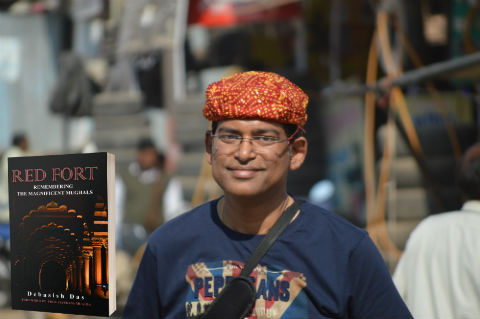
Debasish Das – The Author Of – Red Fort: Remembering the Magnificent Mughals
On a broader view, I find such exchanges of literary reviews encourages reading habit in society as well as critical acclaim deserving books. I wish a bright future to ThinkerViews.
Thank you so much Mr. Das for your appreciation and encouragement.
Quick Purchase Links:
- Buy Book From Amazon India – Paperback
- Buy Book From Amazon India – Kindle EBook
- Buy Book From Amazon US – Paperback
- Buy Book From Amazon US – Kindle EBook
Over To You:
I hope you have enjoyed the Q/A session with him. And many of your questions might be already answered. Let us know that what do you think about this Interview session? Do you want us to ask anything else to heron your behalf? Do let us know. Also, let us know which other authors you like us to interview? Do let us know your thoughts and remarks via comments below. Do not forget to share this article with your friends over various social networks via Twitter, Facebook and others. And yes, you may like to subscribe to our RSS feeds and follow us on various Social networks to get latest updates for the site to land right in your mailbox.
 ThinkerViews – Views And Reviews Personal views and reviews for books, magazines, tv serials, movies, websites, technical stuff and more.
ThinkerViews – Views And Reviews Personal views and reviews for books, magazines, tv serials, movies, websites, technical stuff and more.


